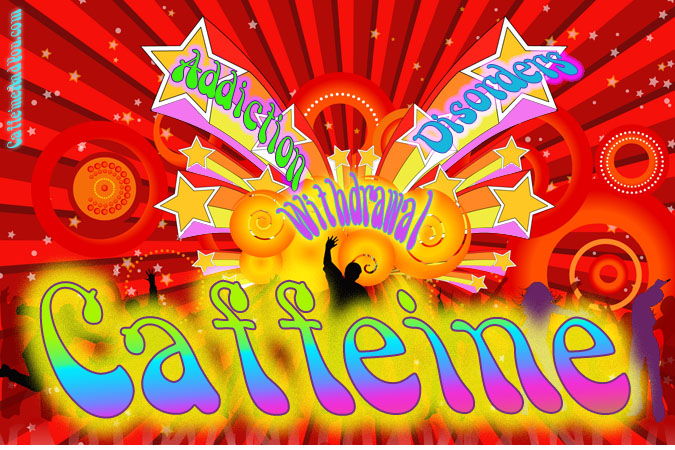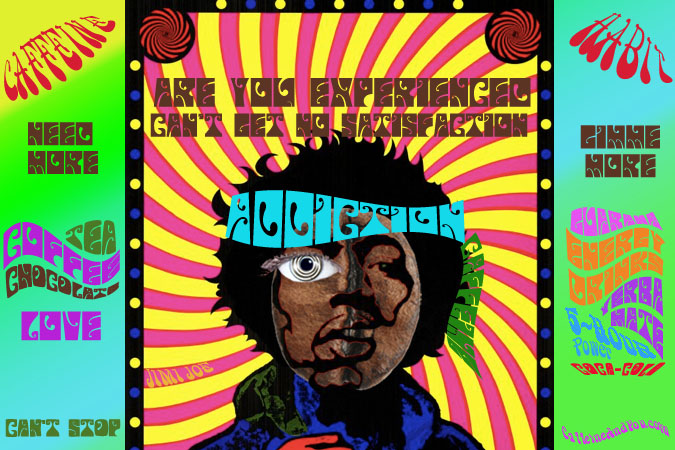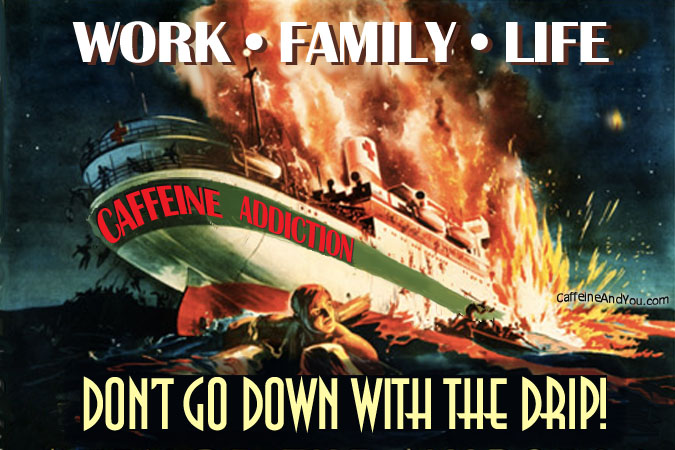In the 1983 film The Big Chill, actress Glenn Close snorts cocaine, something she hasn’t done in decades. In the following scene, she’s sitting up in bed, fidgeting, rambling, and fully awake, while her husband sleeps soundly next to her. The next morning, he’s peppy and ready for a run, while she’s a wrung out rag of exhaustion.
 Caffeine as a drug is a far cry from cocaine. But the two substances have one thing in common: they block sleep. In minutes, caffeine and cocaine turn on your “awake” switch – but shutting down and dozing off isn’t as quick or easy. It takes hours for both drugs to wear off.
Caffeine as a drug is a far cry from cocaine. But the two substances have one thing in common: they block sleep. In minutes, caffeine and cocaine turn on your “awake” switch – but shutting down and dozing off isn’t as quick or easy. It takes hours for both drugs to wear off.
The length of time a drug stays in the body is measured by its half-life; it’s the time it takes for half the substance to be eliminated from the system.
Cocaine’s half-life is short, about 90 minutes. Caffeine’s is about three times longer, but caffeine is a far less potent psychotropic drug. In either case, after the half-life moment is reached, the substance continues to churn in your system with diminishing impact, until completely eliminated.
My Buzz vs. Your Buzz
My sister-in-law DeAnn drinks iced tea all day. She carries a giant thermal cup of it wherever she goes, refilling frequently so the caffeine-well never runs dry. She has no problem falling asleep at night. But my brother John, her husband, practically buzzes on Sanka, which is 97 percent decaffeinated. He nurses a single refrigerated can of Coke throughout the day, taking a few sips now and then. Give him more caffeine than that, and he’s up all night, fidgeting like Glenn Close, after her cocaine blast in The Big Chill.
When my husband and I sit down for coffee, we each drink a cup a day, yet the caffeine churns longer in my body than his. Why? Because of multiple factors: I’m 100 pounds, a woman, and part Asian. He’s 160-pounds, a man, and Caucasian. Other genetic traits also make a difference.
Liver Enzymes Can Be Fickle
The liver metabolizes caffeine, using enzymes to break caffeine down into compounds (which are sent to the kidneys and expelled through urine). One particular enzyme, with the fetching name CYP1A2, metabolizes caffeine, as well as other substances.
When this enzyme is in large supply – and not particularly busy – caffeine gets processed and eliminated swiftly. But when the enzyme has a larger workload and is in demand by caffeine and other substances simultaneously, it gets spread thin (kind of like multi-tasking). As a result, the half-life for caffeine – or the other elements, or both – can last longer.
In other words, other substances can speed up or slow down the processing of caffeine in your body. What can compete with CYP1A2’s breakdown of caffeine? Drugs, including but not limited to antidepressants, cardio drugs like Lidocaine, and acetominophen (Tylenol), oral contraceptives, and plenty of others.
Some substances that help caffeine be more quickly processed and expelled include: tobacco smoke, grilled meats, and broccoli. Substances and conditions that slow down the processing of caffeine (so its effects last longer) include alcohol, pregnancy, liver disease, obesity, and possibly even grapefruit juice.
Half-Life Variables
Weight, body mass, sex, age, race, genes, liver function, concurrent medications, and other factors can influence how fast or slow each individual metabolizes caffeine.
So the half-life of caffeine isn’t a fixed number, and even experts disagree on a standard. In this book, I use 4 hours as the rule-of-thumb, but the half-life of caffeine in a healthy adult may range from 3 to 7.5 hours.
Here are some examples of how caffeine’s half-life can vary:
- Asians metabolize caffeine more slowly than Causasians
- Smokers metabolize caffeine 50 percent faster than nonsmokers; that is, it stays in their system for a shorter period of time (ever notice that smokers consume more coffee than nonsmokers?)
- Alcohol reduces the time it takes to metabolize caffeine; drinkers feel caffeine’s effects longer
- Liver disease makes caffeine more difficult to process; the half-life can last 96 hours in persons with severe liver disease
- Oral contraceptives double the time it takes to metabolize caffeine; the half-life ranges from 5 to 10 hours
- Pregnancy boosts the half-life of caffeine; caffeine’s half-life is 9 to 11 hours in pregnant women.
- In infants and young children, the half-life is longer than in adults; caffeine’s half-life in a newborn may last 30 hours or more.
- The larger the dose, the longer the half-life: Unlike other drugs, caffeine’s half-life is longer at higher doses. In other words, 600 mg of caffeine stays in the system as much as 3 hours longer that of a typical dose of 100-200 mg, which is around 4 hours in most people.
I’ve got more on women, babies and caffeine later in this book. But first, there’s an exciting insight into caffeine’s half-life, and it has to do with our genetic code.
Up next: The caffeine gene determines if you’re a fast metabolizer of caffeine, and it may predict heart attacks…





